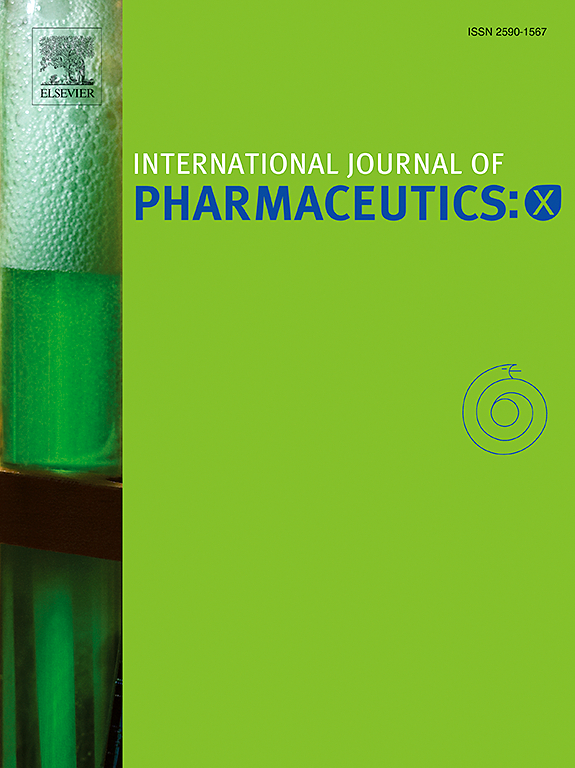纳米结构脂质载体口服山柰甲氧基黄酮对肥胖和血脂异常治疗的影响
IF 6.4
2区 医学
Q1 PHARMACOLOGY & PHARMACY
引用次数: 0
摘要
山柰提取物(Kaempferia parviflora, BG),俗称黑姜,是一种原产于泰国和其他东南亚国家的植物。它的甲氧基黄酮是一种活性化合物,广泛用于膳食补充剂。然而,由于其稳定性差,胃肠道生物利用度低,吸收有限,口服给药面临挑战。本研究开发了一种包裹BG的纳米结构脂质载体(NLC),通过口服给药提高胃肠道稳定性、生物利用度和疗效。BG-NLC呈均匀球形,平均粒径为99.15±0.09 nm, zeta电位为- 25.37±0.99 mV, PDI为0.19±0.01。颗粒在4°C, 25°C和40°C下储存三个月时表现出高稳定性,符合亚洲保健品稳定性指南。此外,BG- nlc在模拟胃液(SGF)和肠液(SIF)中表现出优异的物理化学稳定性,与BG相比,可显著提高肠道吸收和通透性约10 - 30%。体外研究表明,BG- nlc显著降低了分化脂肪细胞的脂质积累和甘油三酯的产生,超过了BG的性能。高脂饮食诱导肥胖小鼠模型的体内研究进一步证明了BG生物利用度的改善,导致体重、体重指数(BMI)以及肝脏和脂肪组织重量的降低。总之,BG-NLC在模拟胃肠道条件下具有高稳定性,改善肠道吸收,显著的抗脂肪生成作用,以及调节血糖的潜在益处。这些发现突出了BG-NLC作为一种针对代谢相关疾病的健康补充剂和药物产品的新型有效配方的潜力。本文章由计算机程序翻译,如有差异,请以英文原文为准。

Oral delivery of Kaempferia parviflora's methoxyflavones via nanostructured lipid carriers: Its effect on obesity and dyslipidemia treatment”
Kaempferia parviflora extract (BG), commonly known as Black Ginger, is a plant native to Thailand and other Southeast Asian countries. Its methoxyflavones are active compounds widely used in dietary supplements. However, their oral administration faces challenges due to poor stability, low gastrointestinal bioavailability, and limited absorption. This study developed a nanostructured lipid carrier (NLC) encapsulating BG to enhance GI stability, bioavailability, and efficacy via oral administration. The BG-NLC exhibited a homogeneously spherical morphology with an average size of 99.15 ± 0.09 nm, a zeta potential of −25.37 ± 0.99 mV, and a PDI of 0.19 ± 0.01. The particles demonstrated high stability during storage at 4 °C, 25 °C, and 40 °C for three months, following Asian health supplement stability guidelines. Furthermore, BG-NLC showed excellent physicochemical stability in simulated gastric (SGF) and intestinal fluids (SIF), significantly enhancing intestinal absorption and permeability by approximately 10–30 % compared to BG. In vitro studies revealed that BG-NLC significantly reduced lipid accumulation and triglyceride production in differentiated adipocytes, surpassing the performance of BG. In vivo studies in a high fat-diet induced obesity mouse model further demonstrated improved BG bioavailability, resulting in reductions in body weight, body mass index (BMI), and liver and adipose tissue weights. In summary, BG-NLC exhibits high stability in simulated GI conditions, improved intestinal absorption, and notable anti-adipogenic effects, alongside potential benefits for blood sugar regulation. These findings highlight the potential of BG-NLC as a novel and effective formulation for health supplements and pharmaceutical products targeting metabolic-related diseases.
求助全文
通过发布文献求助,成功后即可免费获取论文全文。
去求助
来源期刊

International Journal of Pharmaceutics: X
Pharmacology, Toxicology and Pharmaceutics-Pharmaceutical Science
CiteScore
6.60
自引率
0.00%
发文量
32
审稿时长
24 days
期刊介绍:
International Journal of Pharmaceutics: X offers authors with high-quality research who want to publish in a gold open access journal the opportunity to make their work immediately, permanently, and freely accessible.
International Journal of Pharmaceutics: X authors will pay an article publishing charge (APC), have a choice of license options, and retain copyright. Please check the APC here. The journal is indexed in SCOPUS, PUBMED, PMC and DOAJ.
The International Journal of Pharmaceutics is the second most cited journal in the "Pharmacy & Pharmacology" category out of 358 journals, being the true home for pharmaceutical scientists concerned with the physical, chemical and biological properties of devices and delivery systems for drugs, vaccines and biologicals, including their design, manufacture and evaluation. This includes evaluation of the properties of drugs, excipients such as surfactants and polymers and novel materials. The journal has special sections on pharmaceutical nanotechnology and personalized medicines, and publishes research papers, reviews, commentaries and letters to the editor as well as special issues.
 求助内容:
求助内容: 应助结果提醒方式:
应助结果提醒方式:


